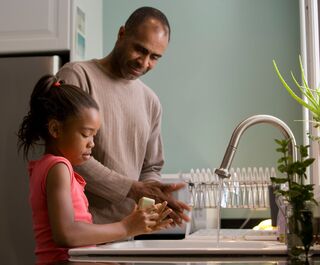Coronavirus Disease 2019
A Parent Decides to Send Her Kids to School During COVID-19
An example of thinking carefully about the risks.
Posted August 26, 2020

I recently wrote a blog post on risk reduction factors for parents who are wondering what to do about school this fall. Shortly after posting, I read a Facebook post from a friend of mine, in which she described the decision-making process she and her husband went through before opting for their kids to go back to school.
To begin with, and perhaps the most important thing to remember as you think about all this, is that every family is unique, and juggling their own unique blend of constraints and considerations. Here is my friend Amy’s description of their family context: “We are (thankfully) healthy with no co-morbidities and have kids who are able to tolerate masks, and who are eager to return to school to grades 3 and 6. Things would be very different if any of us had at-risk co-morbidities. We're also two self-employed parents who work full-time (or try to!), with no paid sick/vacation/family leave and who rely on in-person schooling to educate our kids. We have the ability to work from home and quarantine without significant penalty should one or both kids bring home COVID-19. (I recognize that this is a privilege.)”
Here are the risk factors I listed in my earlier post, this time with Amy’s description of her and her husband’s observations:
- Community numbers. “Halton County continues to have low levels of new infections with 0.57 new infections over the past 7 days (rolling average) despite phase 3 opening as of July 24th. The prevalence for our town is even lower.”
- Small classes, bubbled. “My kids' entire school (JK-8) is less than 200 kids. No guarantees re: class sizes but I'm hopeful that the low disease prevalence, masking, and building/structural issues will protect the kids to a large extent.”
- Fresh air. “Halton's schools have good windows and mechanical ventilation systems that allow for good amounts of fresh air intake/ventilation.”
- Staggered schedules. Amy didn’t mention this factor in her Facebook post, but the very small school population helps prevent the crowding staggered schedules aims to avoid.
- Masks. “Masks are required for all kids from JK-12.”
- Social distancing. Amy doesn’t mention social distancing, but she does say, “Classrooms are fairly spacious, so that helps.”
- Hand hygiene. “Handwashing stations are already installed in all classrooms, and bottle filling stations are in place already.”
- Classroom cleaning. Although Amy doesn’t mention this, it is one factor the Ontario government is emphasizing, and can probably be taken for granted, especially in the small school Amy’s children will be attending.
- Daily screening. Amy doesn’t mention this, but it has been a point of emphasis by local public health officials. She is a medical health professional herself, with a graduate degree in public health, and will be paying attention to what’s happening on this front, ready to advocate for her (and all) kids if necessary.
- Testing. As with daily screening, Amy doesn’t mention this in her post but will be watching to ensure it’s done right.
- Tracing and isolation. Local public health officials have been vocal about the urgent necessity of this. Amy will be ready to jump in if needed.
- Getting to school. Amy doesn’t mention this, but I’m guessing that means she and her husband will be taking the kids to school and not sending them by bus.
Amy finished her Facebook post by saying, “I am, of course, in no way trying to give advice or speak to the micro-contexts of other families. This is just my reflection and FYI on our choice to send our kids back.”
Amy’s description of her family’s deliberations illustrates how tough the decision is this fall, as well as offers a great example of how to make the decision by taking into account your personal variables (the health, ages, and needs of each family member), the local context including both the disease numbers and the community response to the virus, and the school situation regarding masks, ventilation, hygiene, and space.
Nobody has much control over anything right now, and there is so much that we can’t know about what will happen next, so it is a time of widespread anxiety, confusion, and frustration. As I wrote in my previous post, and as Amy’s post illustrates, knowing what to pay attention to can help you assess your risks, and inform your decision, giving you as much control over the situation as possible.
Remember that no matter what you decide, it will not be perfect. Most families do better when school is happening as usual, but school-as-usual is inherently risky now. Whatever decision you make, go easy on yourself, and respect whatever decisions other people are making. Each of us is doing the best we know how with a dreadfully uncertain situation, so (in the words of British Columbia’s top COVID doctor Bonnie Henry) “Be kind, be calm, be safe.”


